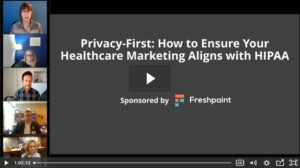Privacy-First Marketing: HIPAA Guidance for Your Healthcare Communications
By prioritizing patient privacy and data security, healthcare organizations can implement marketing strategies without compromising patient trust.
// By Elaine Christie //
 What does it really mean to embrace a privacy-first communications approach? That’s just one of the many questions we wanted to answer during a recent webinar, Privacy-First: How to Ensure Your Healthcare Marketing Aligns with HIPAA.
What does it really mean to embrace a privacy-first communications approach? That’s just one of the many questions we wanted to answer during a recent webinar, Privacy-First: How to Ensure Your Healthcare Marketing Aligns with HIPAA.
This webinar was presented on February 1, 2024 by eHealthcare Strategy & Trends. The panel discussion explored safer ways to gather customer journey insights using tracking tools while protecting sensitive information and maintaining compliance with HIPAA.
The panel included:
- Ray Mina, Head of Marketing, Freshpaint
- Doriann Cain, Partner, Faegre Drinker
- Bridget O’Connor, COO, Fortalice Solutions
- Edward Rafalski, Chief Strategy & Marketing Officer, BayCare Health System
This article recaps their insightful conversation, offers tips for creating a safer-by-default tech stack that still offers clear visibility into the customer journey, and shares answers to these privacy-first marketing questions:
- What it means to have a privacy-first approach.
- Why web trackers don’t comply with HIPAA.
- Which tools need a Business Associate Agreement.
- Who should be involved in making these decisions and changes.
- What options to consider for an audit.
What Is a Privacy-First Approach?
A privacy-first approach to healthcare marketing is simply using a strategy that respects patient privacy. It can feel as though the phrase “privacy first” is thrown around in all types of industries, and rightfully so. In today’s world, companies that don’t embrace a privacy-first mindset set themselves up for several risks.
First, and most obvious, is the risk of violating HIPAA when it comes to protected health information (PHI). This could lead to legal repercussions, hefty fines, and a negative impact on your organization’s brand image.
Second, and perhaps less obvious, are cybersecurity risks. In the evolving landscape of healthcare data protection, taking a privacy-centric strategy can also minimize cybersecurity threats and compromising of sensitive patient information.
Third, lack of a privacy-first mindset may hinder adoption of advanced technologies and personalized marketing tactics. This would be a missed opportunity and limit your ability to reach and engage patients in a meaningful, targeted manner.
Mina suggests that a privacy-first approach to digital marketing is a journey, not a sprint. Therefore, it requires a high level of strategy to make it work successfully.
“It’s not stopping and turning off everything. It’s not abandoning the ecosystem of tools that you like, because like it or not, this is where we find our consumers today. It’s making sure that there is actually a process internally, probably layers of technology, and a thought process around understanding what data might be shared,” says Mina.
Why Web Trackers Don’t Comply with HIPAA
A little over a year ago, HHS and OCR issued a HIPAA bulletin focused on consumer privacy and use of tracking technologies. Some people were concerned the new rules would bring digital healthcare marketing to a screeching halt. It hasn’t.
But, and here’s the catch, you’re still liable in lots of different scenarios. You need to consider anything touching live traffic —
- whether or not you’re a regulated entity under HIPAA.
- whether or not you use the data obtained from tracking for marketing purposes.
- whether or not you’re aware that you’re leaking sensitive data.
- even if you hired someone else to design your website or build your app.
- even if you didn’t know about tracking tools.
Engaging in a risk assessment process will help you develop a process for achieving and maintaining compliance.
According to Bridget O’Connor, a partner and COO at cybersecurity firm Fortalice, this means auditing any type of data touching live web traffic for patients and/or consumers. She suggests the first step is awareness and the next step involves incorporating these rules into your processes.
“We thought we would put together a process around trying to help healthcare organizations, because at first there really wasn’t a lot of information out there. There weren’t a lot of firms like ours that were really doing that work and trying to help educate organizations,” says O’Connor.
Which Tools Need a BAA?
Another important step is looking at your marketing technologies and their potential interaction with patient data. That’s where a Business Associate Agreement (BAA) comes in. Here’s how it works:
- It holds the marketing team accountable for complying with HIPAA regulations.
- It establishes the terms under which they can use and disclose PHI.
- It proves the hospital took reasonable steps to ensure compliance.
In essence, this legal agreement outlines the responsibilities and obligations with a business associate when handling PHI. Here are some common platforms that often require a BAA:
- Email marketing platforms: If the marketing platform has access to PHI, a BAA is typically required.
- Customer relationship management systems: Many CRM systems used in healthcare marketing may involve storage or processing of PHI, necessitating a BAA.
- Healthcare advertising: Advertising networks that handle patient data may need to sign a BAA.
- Data analytics and business intelligence tools: Tools that analyze healthcare data may also require a BAA.
- Patient engagement platforms: Technologies that involve patient communication and engagement may handle PHI.
- Telemedicine: Almost all telehealth services handle PHI, and a BAA is generally required.
The panel agreed that if you have any doubt about whether a technology involves PHI or not, you should consult with your legal and compliance teams. They also noted that healthcare is, in general, looked at as a very “trusted” industry.
Ed Rafalski, Chief Strategy & Marketing Officer, BayCare Health System in Tampa, says this type of trustworthy reputation mandates a higher level of accountability. “I think to maintain that level of integrity and trust, it goes back to the privacy-first question. When someone hands over their information, they’re giving us their trust. It’s our job to make sure we protect it.”
Whom to Involve
Another topic that came up during the webinar was about who should be involved in defining and implementing these new processes. Is there a minimum group of people that should be involved? How should you even construct your team? Should you also have technical training with the IT team?
When you go to form these groups, ideally, you’re including marketing, legal, compliance, and auditing, but there’s one more step.
O’Connor, with cybersecurity firm Fortalice, says it’s very important that as these groups form, they allow for organic, natural exchange of ideas. She says, “I actually encourage them to get all their questions out, because there’s a lot to cover for marketing folks, anybody from IT and HR, to actually understand what the OCR rules mean.”
Which Options to Consider for an Audit?
One question that came up during the webinar was about which options to consider for an audit. O’Connor notes that the first step is to take an inventory of all of your sites. Do you have the right BAA in place? Are you taking steps to monitor this continuously?
“You really are going to have to think about this in a cyclical way. The worst-case scenario is to think of this as one and done. I saw that happen, and I don’t wish that on anyone, because what happened was, they got hit with a class-action lawsuit. So, think of this as something that you just need to incorporate into your processes,” says O’Connor.
Privacy and cybersecurity attorney Doriann Cain agrees that processes to make privacy-related issues need to be continuous, or as she says, “baked into your privacy program.”
Unlocking Technologies and Tactics
Remember — it’s important to prepare, not panic. Regulatory “red tape” shouldn’t deter you from developing targeted, meaningful campaigns.
A privacy-first approach to marketing can unlock technologies and tactics that many healthcare organizations have considered off-limits until now. Indeed, organizations that have adopted new processes successfully use tracking tools without risking a HIPAA breach.
A privacy-first approach might help you open up some great opportunities. By prioritizing patient privacy and data security, you can try out advanced analytics, artificial intelligence, and personalized marketing strategies without compromising patient trust.
Here are a few benefits of using anonymized data and adopting consent-driven methodologies:
- You can leverage sophisticated tools to identify and engage potential patients.
- You can tailor messaging based on individual needs.
- You can optimize marketing strategies for better patient outcomes.
Wrapping Up
A privacy-first approach does more than simply safeguard patient information. It’s an approach that paves the way for hospitals to explore and implement cutting-edge technologies, ultimately contributing to enhanced patient engagement, loyalty, and sustainable revenue growth.
Ensuring your healthcare marketing aligns with HIPAA is not a one-and-done task. It’s always a good idea to stay updated on HIPAA regulations and study how they apply to your specific role as a healthcare marketer. When choosing online tracking technologies, seek out tools that protect against the unauthorized disclosure of protected health information.
Elaine Christie is a trained journalist, technology advocate, and frequent writer about digital transformation, internet marketing, and cybersecurity.
Related Articles
Privacy-First: How to Ensure Your Healthcare Marketing Aligns with HIPAA [Webinar]
Focus on Privacy/Tracking: Strategies to Navigate the Risks and Maintain Compliance [eBook]


